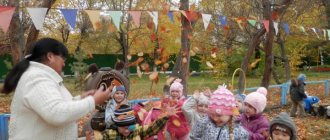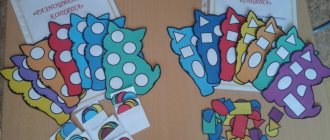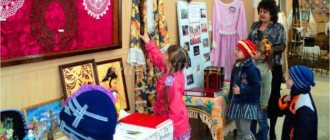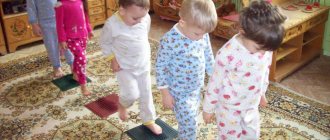“The development of the child as a whole, and not just the purity of his native speech, then, the entire intellectual development of the child and, finally, the development of character, emotional development - all this reflects the direct influence of speech.”
Lev Semyonovich Vygotsky
The Federal State Educational Standard for Preschool Education has defined target guidelines - the social and psychological characteristics of a child’s personality at the stage of completion of preschool education. Among which, speech occupies one of the central places as an independently formed function, namely: by the end of preschool education, a preschool education student understands oral speech well and can express his thoughts and desires.
Speech is also included as an important component, as a means of communication, cognition, creativity and other targets. Thus, none of the targets can be achieved without mastering speech culture. To achieve the GEF targets, systematic prevention and correction of speech disorders is necessary.
Preschool age is the most favorable for the development and formation of speech in children, and its deficiencies at this time are easier and faster to overcome. Speech activity that is defective for one reason or another has a negative impact on the formation of the child’s mental sphere and the development of his personal qualities.
First of all, defects in speech function lead to impaired or delayed development of higher mental functions mediated by speech: verbal memory, semantic memorization, auditory attention, verbal-logical thinking. This is reflected both in the productivity of mental operations and in the rate of development of cognitive activity. In addition, a speech defect leaves an imprint on the formation of a child’s personality and makes it difficult for him to communicate with adults and peers.
Objectives of speech development in the Federal State Educational Standard of Education
- mastering speech as a means of communication and culture (this means that it is necessary to form children’s oral speech at such a level that they do not experience difficulties in establishing contacts with peers and adults, so that their speech is understandable to others);
- enrichment of the active vocabulary (occurs at the expense of the preschooler’s main vocabulary fund and depends on our dictionary and the dictionary of the parents; to expand the vocabulary of children, favorable conditions are created with comprehensive thematic planning of work);
- development of coherent, grammatically correct dialogical and monologue speech (our coherent speech consists of two parts - dialogue and monologue. The building material for it is a dictionary and mastering the grammatical structure of speech, i.e. the ability to change words, combine them into sentences);
- development of speech creativity (the work is not easy, it assumes that children independently compose simple short stories, take part in composing poetic phrases, come up with new moves in the plot of a fairy tale, etc.). All this becomes possible if we create the conditions for it;
- acquaintance with book culture, children's literature, listening comprehension of texts of various genres of children's literature (The main problem is that the book has ceased to be a value in many families, children do not gain the experience of reading at home - listening, the book should become a companion for children);
- the formation of sound analytical-synthetic activity as a prerequisite for learning to read and write;
- development of sound and intonation culture, phonemic hearing (the child learns the stress system, pronunciation of words and the ability to speak expressively, read poetry).
One of the key places in the system of mastering speech culture by preschool children is occupied by a speech therapist teacher.
Basic documents regulating the tasks, content and forms of organization of the correctional pedagogical process in preschool educational institutions (for children with severe speech impairment):
Law of the Russian Federation “On Education” N 273-FZ;
Federal Law “On Special Education of Persons with Disabilities”;
Order of the Ministry of Education and Science of Russia dated October 17, 2013 N 1155 “On approval of the federal state educational standard for preschool education” (Registered with the Ministry of Justice of Russia on November 14, 2013 N 30384).
My activities in the correction of speech disorders are based on a traditional, classical program:
- System of correctional and developmental work in the speech therapy group of a kindergarten with general speech underdevelopment (4-7 years). Nishcheva N.V. St. Petersburg: 2007.
Every academic year, a primary speech therapy examination of children in the senior group is carried out according to O.B. Inshakova. Based on the results of the initial examination of the speech system, 12 children aged 5-6 years are recruited for classes with a speech therapist teacher and a plan of correctional and developmental work is drawn up for the entire school year.
When designing a correctional and developmental process, I take into account the following correctional and pedagogical principles:
- consistency;
- complexity;
- development principle;
- consideration of speech disorders in relation to other aspects of the child’s mental development;
- the principle of taking into account the structure of a speech defect;
- the principle of a workaround for correcting deficiencies in speech development;
- the principle of taking into account the zone of proximal and actual development.
In my opinion, for the successful implementation of the correctional educational process, the creation of a subject-development environment plays an important role: equipping the speech therapy room with the necessary equipment, didactic materials and visual aids. A subject environment with developmental components has been created in the classroom. Scientific and methodological support of the educational process has been systematized, speech therapy documentation is maintained, and an information block for teachers and parents operates.
The main organizational forms of speech therapy work were chosen:
– individual speech therapy work;
– subgroup speech therapy work, which is carried out within the framework of direct educational activities, directly organized activities, joint activities of the teacher and children.
All speech therapy work is carried out in the form of speech gymnastics, speech therapy training, communicative games, lexical and grammatical games, etc.
I consider the most acceptable methods in practical work to be explanatory and illustrative, reproductive, partly search, communicative, information and communication; methods of control, self-control and mutual control.
Also, in correctional work with children with speech impairments, I use the following health-saving technologies:
- articulation gymnastics,
- breathing exercises,
- finger and visual gymnastics,
- self-massage.
Correction of the speech system is impossible without the interaction of a speech therapist with teachers and parents. Therefore, I allocate a key place to this block of my activity. Work with parents is carried out in the following forms:
- speaking at parent meetings with reports on current work and its effectiveness;
- organizing individual conversations with parents, consultations on conducting speech exercises with children;
- conducting seminars and workshops;
- education through information stands in group locker rooms.
Work with educators is carried out through familiarization with the results of a speech therapy examination, speech therapy programs, and the tasks of correctional work for the school year; consultations on various topics.
For a more detailed analysis of my work, I suggest that you familiarize yourself with Table No. 1, which reflects all areas of the correctional and developmental process in the period from September 2022 to May 2022.
Table No. 1
| Month, year | correctional and developmental activities with children | interaction with teachers | interaction with parents |
| September 2020 | 1.Primary speech therapy examination of children of the middle, senior and preparatory groups. 2.Individual lessons according to an individual speech therapy support program 3. Subgroup logorhythmic lessons on the topics: “To speak clearly, you need to be friends with your fingers”; "Acquaintance with Tongue's House" | Familiarization of educators with the lists of children enrolled in speech therapy classes and the schedule. | Organizational meeting with parents of enrolled children (preparatory group). |
| October 2020 | 1.Individual lessons according to an individual speech therapy support program 2. Subgroup logorhythmic classes on the topics: “Vegetables. Adult labor in fields and gardens”; "Fruits. Labor of adults in gardens"; "Insects and Spiders"; " Migratory birds;. | Design of an interaction notebook. | 1.Designing a speech therapist’s corner on the topics: “Development of coherent speech in children” (preparatory group). 2.Individual consultations. |
| November 2020 | 1.Individual lessons according to an individual speech therapy support program 2. Subgroup lessons on lexical topics: “Berries and mushrooms. Forest in autumn”, “Pets”, “Wild animals of our forests”, “Clothes, shoes, hats”. | Consultations | Individual consultations. |
| December 2020 | 1.Individual lessons according to an individual speech therapy support program 2. Subgroup lessons on lexical topics: “Winter. Wintering birds", "Furniture", "Dishes", "New Year's holiday". | Seminar - workshop. | Design of a speech therapist's corner on the topics: “Articulation exercises” (preparatory group). |
| January 2021 | 1.Individual lessons according to an individual speech therapy support program 2. Subgroup lessons on lexical topics: “Transport”, “Professions”, “Work in the countryside in winter”. | Working with children according to the instructions of a speech therapist. | Individual consultations. |
| February 2021 | 1.Individual lessons according to an individual speech therapy support program 2. Subgroup lessons on lexical topics: “Tools of labor. Tools", "Defender of the Fatherland Day", "Animals of Hot Countries"; "Houseplants". | View GCD on speech development. | 1. Conversation “Enriching vocabulary” (preparatory group). 2.Individual consultations. |
| March 2021 | 1.Individual lessons according to an individual program. 2. Subgroup lessons on lexical topics: “Early spring. Mother’s holiday”, “Our Motherland-Russia”, “Moscow is the capital of Russia” | View GCD on speech development. | 1.Designing a speech therapist’s corner on the topics: “Children’s mastery of syllabic analysis of words” (preparatory group). 2.Individual consultations. |
| April 2021 | 1.Individual lessons according to an individual speech therapy support program 2. Subgroup lessons on lexical topics: “We read S.Ya. Marshak, K.I. Chukovsky, S.V. Mikhalkov, A.L. Barto" | Consolidation of acquired knowledge. Differentiation of delivered sounds. | 1. Questioning of parents whose children attended speech therapist classes. 2.Individual consultations. |
| May 2021 | 1.Individual lessons according to an individual plan. 2. Subgroup lessons on lexical topics: “Late spring. Insects in the spring”, “We read. A.S. Pushkin", "School. School supplies." | Filling out the performance table. | 1. Final parent meeting based on the results of the year. 2. Conversation “For those who go to school” (preparatory group). |
The final result depends on the severity of the speech disorder, on the child’s attitude towards his defect, on the general intellectual development of the child, on the parents’ understanding of the importance of correctional work and their participation in the correctional process.
By analyzing the final indicators of the speech development of children enrolled in classes with a speech therapist in the previous year, it is possible to identify positive dynamics in the development of speech culture.
The established system of work has a beneficial effect on improving children's speech. The leading role in speech development is played by an equipped developing subject-spatial environment. Correctional work with children, in turn, helps eliminate speech underdevelopment, which improves the development of all mental processes. It is also necessary to note that speech literacy helps children establish communication with peers and adults. It is important to remember that a necessary condition for positive dynamics is the education of parents in matters of correction of speech development.
Summarizing the above, we can conclude that in our preschool educational institution the necessary psychological and pedagogical conditions have been created for the full speech development of preschool children, but despite this, we continue to work on the formation and development of children’s speech.
Generalization of the work experience of a speech therapist teacher. Use of ICT
USE OF INFORMATION AND COMMUNICATION TECHNOLOGIES IN THE PRACTICAL ACTIVITIES OF A TEACHER – Speech Therapist
We chose this topic for a reason, since computers have taken a strong position in many areas of modern life, including in kindergartens.
Computer technology, being the most modern tool for processing information, can play the role of an indispensable assistant in the upbringing and education of a child, as well as in the formation of the speech and general mental development of preschoolers and serve as a powerful technical teaching tool. The topic of using a computer in the work of a speech therapist is an in-depth topic that I work on in my daily practice. Why her? Firstly, I am interested in this, and secondly, I dared to assume that my students should like it and have a positive impact on the process of correcting speech disorders. And thirdly, I, as a young specialist, was faced with a lack of methodological material for my work and small spaces in the log center office for storing various paintings, illustrations, numerous card files, etc. Hence the decision - to use computer technology in all aspects of their practical activities. I regularly use computer technologies in my work - when building a correctional process directly with children, when working with parents, as well as when maintaining reporting documentation at the speech center.
I would like to especially focus on the point that the process of teaching a child with a speech disorder requires a long time and takes a lot of energy from him. The child loses interest in classes with a speech therapist over time, since such correctional activities are often monotonous in nature, and the desire to speak “correctly and beautifully” is lost. And if we take into account the fact that currently the number of children whose speech disorders are accompanied by attention deficit hyperactivity disorder has increased, we can state that a special individual approach is required when working with such children. They need constant emotional support in the classroom, which is facilitated by the use of ICT.
One of the current areas for introducing information technology into the work of a speech therapist is the use of multimedia presentations. They allow you to bring a visual effect to the lesson and increase the motivational activity of children. Each thematic week of kindergarten is reflected in my activities, so that the child receives the necessary amount of knowledge on this topic in a whole week. Such themes suggest which hero will ask us for help or who we will go to visit. With the help of presentations, we go on a journey with the main character, encounter obstacles along the way, and overcome them. Thanks to the sequential appearance of images on the screen, children are able to complete the exercises more carefully and fully. The use of animation and surprise moments makes the correction process interesting and expressive. Children receive approval not only from the speech therapist, but also from the computer in the form of prize pictures accompanied by sound design. At the end of each journey we always receive rewards! This delights the children. Presentations also allow you to show children something they have never seen - for example, the lands of Africa, their inhabitants, national clothes, etc. With the help of presentations, abstract concepts such as friendship, mutual assistance, feelings and emotions of people, etc. can be explained to children.
One of the means of optimizing the correction process can be computer games. I look for some flash games on the Internet. But mostly I create such games myself. The themes of the games are suggested to me by daily practical activities. The latest games I created: this is the game “The Fourth Wheel”; Game for the development of word formation “In the kitchen”; “What first, what then”; “Generalizing concepts”, and labyrinths for various sounds for their automation. I also create card indexes in various areas in the multimedia presentation program. At the present time, this is very important, since the card system of various didactic materials in the work of specialized specialists again occupies a strong place. These include cards for automating sounds, a series of plot pictures, cards for the development of phonemic awareness, etc. Such already laminated cards look aesthetically pleasing, bright and will serve any specialist for a long time. It is impossible not to note the importance of ICT as a means of helping to organize one’s professional activities. All diagnostic data, speech cards of pupils, monitoring, lists of children who need speech therapy help, etc. are stored in the computer memory. Accordingly, all documents at the logo point look aesthetically pleasing, neat and comply with the standards for maintaining reporting documentation. Also, using various computer programs, I create the design for the speech therapy stand “Merry Taratorki” and the speech therapist’s office as a whole. ICT also acts as a means of visibility for parents and colleagues. At my speeches at teaching hours and parent meetings, I regularly accompany my speech with multimedia presentations, videos about the work of the speech center, and photo reports of speech therapy events. It can be noted that speeches accompanied by these materials are perceived easier and more interesting. Also on the official website of our kindergarten there is a speech therapist’s office. Here you can see the speech therapist’s work schedule, consultations on various topics, exercises for setting and automating sounds, photo reports of our everyday life and open events. Just recently, another section of the office “To help parents exercise at home” appeared. This idea was suggested to me at a lecture-webinar in Novosibirsk. On the kindergarten website I give exercises for strengthening at home to those children who, due to family circumstances, do not yet have the opportunity to attend kindergarten. This is very convenient and allows you to conduct correctional classes systematically. Also, thanks to the Internet, I had the opportunity to improve my skills through webinars. We listen to lectures by famous teachers of our country, study in depth some aspects of our work, organize round tables, discussing pressing issues, etc. When registering for webinars, I see how teachers from different parts of our vast country are registering - Murmansk, Vladivostok, Kaliningrad... Some specialists listen to the lecture late at night... Understanding that we are all doing one very difficult thing together really encourages me, prompts me, that I am going in the right direction, that I can always seek advice and share my experience with specialists from different regions. Also, using the Internet, I exhibit my achievements, games, consultations on various educational sites... The game “Maze for the sound C”. At the end of my speech, I would like to introduce you to my latest developed game “Labyrinth”. These labyrinths are designed to automate sounds. In front of you on the slide is the game “Labyrinth for sound automation C”. Both the teacher and the child can control the mouse of this game. The background illustration material for each maze is not chosen randomly. If Santa Claus is riding through a snowy forest, and this game is aimed at automating the sound C, then the background illustration will have corresponding images: bullfinches, snowmen, snow, snowflakes, etc. That is, before the very start of the game, you can look at this illustration, ask the child a lot of questions, ask him to write a descriptive story about any element of the picture or the entire illustration as a whole. As you can see, there are not many words along the way. But the point of these labyrinths is not to practice a large number of words with broken sounds. The fact is that during the movement of the main character, the child’s attention is distracted, the child is distracted from the intention to speak a given sound correctly and thus it is possible to check whether the corrected sound is introduced into spontaneous speech or not. Already tested in practice, a computer game attracts the child’s attention, increases the incentive to correct speech disorders, coming to the speech therapist’s office again and again I ask for attention to the game. The speech therapist gives the instruction: “The New Year is coming. All the guys are ready to celebrate, but here’s the problem: the tree is not decorated with toys... What’s New Year without a decorated tree? Santa Claus needs to set off along a winding path so that the Christmas tree will shine with lights and the holiday will begin. To do this we need to help him. As soon as objects appear on the path of Santa Claus, we need to correctly and clearly name these words. Only then will he be able to move on. Ready? Go".
Thus, competent use of a computer, in accordance with sanitary rules and regulations, leads to increased motivation of children to study with a teacher - speech therapist, to an adequate assessment by the child of his actions, to the formation of cooperation between the child and the speech therapist. At the same time, a form of communication is formed between the child and the teacher, which is necessary for both preschoolers and junior schoolchildren to study at school. At the same time, the speech therapist also has an incentive to work and an interest in further organizing his activities. The interest becomes mutual, and this is the key to successful work.
We recommend watching:
Lesson summary for 1st grade students with level 3 OHP The role of ICT in the educational process Logorhythmics summary for kindergarten Development of correct speech breathing in preschool children
Similar articles:
Information technology in English lessons
Rainbow-talents.RF
author: Fedoseeva Karine Minasovna
teacher-speech therapist MKOU "NSOSH" (DO)
Generalized pedagogical experience on the topic: “Speech therapy rhythm as an effective method of overcoming speech disorders in preschool children”
Municipal state educational institution "Novogurovskaya secondary school"
9preschool education)
Generalized pedagogical experience of a speech therapist teacher
MKOU "NSOSH" Fedoseeva K.M. on this topic:
“Speech therapy rhythm as an effective method of overcoming speech disorders in preschool children”
2019
An obvious fact is that the number of children with various speech development disorders is increasing every year. And speech therapists are constantly searching for new methods and techniques that would help increase interest in classes and the effectiveness of correctional interventions. Having studied and analyzed the methodological literature, for me the most effective method of overcoming speech disorders that meets these requirements was the use of speech therapy rhythms.
Speech therapy rhythmics
is a system of movements combined with music and words.
Logorhythmics occupies a special place in the system of a comprehensive method of correctional work with preschoolers and serves the purpose of normalizing motor functions and speech, including breathing, voice, rhythm, tempo and melodic-intonation aspects of speech.
The activity was based on the position of psychophysiology on speech processes as a complex system of sensorimotor coordination (I.M. Sechenov, I.P. Pavlov, A.R. Luria, A.N. Leontiev, N.A. Bernstein); position of L.S. Vygotsky about the leading role of teaching and upbringing in the mental development of a child; author's methods on logorhythmics O.A. Novikovskaya, G.A. Volkova, where the goals, objectives and content of logorhythmics with children with various deviations in speech development are revealed, M.Yu. Kartushina, N.V. Miklyaeva, V.T. Taran, A.E. Voronova and others.
The importance of rhythmic and logorhythmic effects on people has been emphasized by many researchers. So, V.M. Bekhterev believed that by identifying rhythmic reflexes it is possible to adapt the child’s body to respond to certain stimuli (auditory and visual), establish balance in the activity of the child’s nervous system, moderate overly excited children and disinhibit inhibited children, regulate incorrect and unnecessary movements.
V.A. Gilyarovsky wrote that speech therapy rhythms influence the general tone, motor skills, and mood; it helps train the mobility of the nervous processes of the central nervous system and activate the cortex. E.V. Chayanova, E.V. Konorov believed that speech therapy rhythm develops attention (its concentration, volume, stability, distribution), memory (visual, auditory, motor, logical, complex). V.A. wrote about the importance of speech therapy rhythms for correcting people’s speech. Greener, N.S. Samoilenko, N.A. Vlasova, D.S. Ozeretskovsky, Yu.A. Florenskaya. They emphasized the general pedagogical influence of rhythm on various painful deviations in the psychophysical sphere of a person, as well as the fact that speech therapy rhythm affects the physical, moral, intellectual and aesthetic education of a person.
Purpose
Speech therapy rhythmics is to overcome speech disorders through development, education and correction of the motor sphere in people with speech pathology in combination with words and music and ultimately adaptation to the conditions of the external and internal environment.
Tasks
speech therapy rhythms:
—
recreational - speech therapy rhythm classes strengthen the musculoskeletal system, develop breathing, motor functions, and cultivate correct posture and gait;
—
educational (cognitive) - the implementation of educational tasks contributes to the formation of motor skills and abilities, spatial concepts and the ability to voluntarily move in space relative to other people and objects; development of agility, strength, endurance, movement coordination, and organizational skills. With the help of speech therapy rhythm classes, people with speech pathology acquire theoretical knowledge in the field of metrhythmics, musical culture, musical perception and impressionability. All this contributes to mental, moral, aesthetic and labor education.
—
The educational objectives of these classes are varied:
- education and development of a sense of rhythm, the ability to sense rhythmic expressiveness in music, movements and speech;
- nurturing the ability to perceive musical images and the ability to move rhythmically and expressively in accordance with this image, i.e. nurturing the ability to transform and demonstrate one’s artistic and creative abilities;
- nurturing personal qualities, a sense of teamwork, the ability to follow the rules of doing exercises, etc.
— correctional tasks — the correctional focus of logorhythmic classes is determined by the step-by-step nature of speech therapy work in eliminating various speech disorders.
Thus, speech therapy rhythm is the most emotional part of speech therapy activity, combining the correction of speech disorders with the development of sensory and motor abilities of children. Under the influence of speech therapy rhythm classes, preschool children experience significant changes in sound pronunciation, word formation, and the accumulation of active vocabulary. And, despite its organized system, logorhythmics is an addition to speech therapy classes and is included in elements of the speech therapist’s classes. Based on the above, we can conclude that the use of logorhythmic elements in the system of correctional work and prevention of speech disorders will increase the level of speech development of preschool children. This determines the relevance of the chosen topic.
The purpose of self-education
– study of health-saving technology “Speech therapy rhythm”, selection and systematization of methodological and practical material for introducing this technology into the educational process with preschool children with speech disorders.
Tasks:
- Studying psychological, pedagogical and methodological literature on the chosen topic.
2.Development of practical and methodological material for introducing technology into the educational process.
3.Creating favorable conditions for children, establishing contact with each child in order to identify his motor and musical capabilities.
The means of speech therapy rhythm are:
- walking and marching in different directions;
— exercises to develop breathing, voice and articulation;
- exercises that regulate muscle tone;
- exercises that activate attention;
- counting exercises that develop a sense of musical meter;
- exercises that develop a sense of musical tempo;
- rhythmic exercises;
- singing;
- exercises in playing instruments;
— independent musical activity with speech disorders;
— gaming activity;
— exercises for developing creative initiative.
The basic principle of constructing all of the listed types of work is the close connection of movement with music, the inclusion of speech material. The word can be introduced in a wide variety of forms: these are the texts of songs, round dances, dramatizations with singing, dramatizations on a given topic, the driver’s commands in outdoor games, etc. The introduction of words also makes it possible to create a whole series of exercises guided not by musical rhythm, but by rhythm in poetic form, which allows one to maintain the principle of rhythm in movements. The means of speech therapy rhythmics can be represented as a system of gradually more complex rhythmic, logorhythmic and musical-rhythmic exercises and tasks that underlie the independent motor, musical and speech activity of people with speech disorders.
When working with children in logorhythmics, there are two main areas:
- Development of non-speech processes: improvement of general motor skills, coordination of movements, orientation in space; regulation of muscle tone; development of musical tempo and rhythm, singing abilities; activation of all types of attention and memory.
- Development of speech processes in children and correction of their speech disorders. This work includes the development of breathing, voice; development of a moderate rate of speech and its intonation expressiveness; development of articulatory and facial motor skills; coordination of speech with movement; education of correct sound pronunciation and the formation of phonemic hearing.
I include the following logorhythmic elements in speech therapy classes:
- exercises to music for the development of general motor skills, appropriate to the age characteristics of children, to normalize muscle-motor tone and develop coordination of movements;
- finger exercises for the development of fine motor skills;
- articulation gymnastics;
- vocal-articulation exercises for the development of breathing with and without musical accompaniment and exercises for the development of correct speech exhalation;
- songs and poems, accompanied by hand movements, to develop fluency and expressiveness of speech, speech hearing and speech memory;
- musical games that promote the development of speech, attention, and the ability to navigate in space;
- musical-rhythmic games with musical instruments that develop a sense of rhythm;
- pure phrasing for automation and differentiation of sounds;
- communicative games and dances to develop the dynamic side of communication, emotionality, positive self-awareness;
- Relaxation exercises to relieve emotional and physical stress.
Each speech therapy session necessarily included one or more elements of speech therapy rhythm.
The sequence of correctional work varied in accordance with the nature of speech disorders, individual and age characteristics of the children.
Activity results:
- positive dynamics of the process of the child mastering correct sound pronunciation;
- developing the correct tempo of speech and breathing rhythm;
- development of speech exhalation;
— improvement of speech memory;
- ability to perform breathing and finger exercises, quickly respond to changes in movements;
— development of coordination in accordance with musical accompaniment, which helps reduce psycho-emotional stress and improve children’s health.
Conclusions.
Speech therapy rhythm classes are useful for all children who have problems developing speech function, including delayed speech development, impaired sound pronunciation, etc.
The use of logorhythmic elements in speech therapy classes creates a positive emotional mood for speech, motivation to perform speech therapy exercises; all this helps to normalize the child’s speech, regardless of the type of speech disorder, and also reduces psycho-emotional stress and strengthens the health of children in general.
Bibliography:
- Volkova G. A. Speech therapy rhythm .
M., 2003. - Nishcheva N.V. Speech therapy rhythm in the system of correctional and developmental work in kindergarten. Musical games, exercises, songs. St. Petersburg, 2014.
- Novikovskaya O.A. Logorhythmics for preschoolers in games and exercises. St. Petersburg, 2005.
- Shashkina G.R. Speech therapy rhythm for preschool children with speech disorders M., 2019
Report to the pedagogical council from the work experience “Development of speech in preschool children”
Report to the pedagogical council from work experience
“Speech development in preschool children”
Prepared by: Gileva A.S.
Today, the issue of speech development in preschoolers is especially acute. This is probably due to the fact that children, and adults too, began to communicate more with computers and other means of technological progress than with each other.
Preschool age is the most favorable for the development of speech and the formation of a culture of verbal communication. Practice shows: this is a very labor-intensive and responsible work that requires a certain system and patience on the part of the teacher in selecting the most effective means and methods of teaching.
My job
with children is based on the model of organizing the educational process: joint activities of adults and children are divided into directly organized activities and educational activities carried out during scheduled moments.
When working
on intonation expressiveness of speech, I use pronunciation with children: in a whisper, quietly, loudly. To form a sound culture of speech, I use: articulatory gymnastics, pure speech, good exercises to clarify the pronunciation of consonant sounds, differentiation.
It is important to achieve clear articulation. Each child has a mirror so that children can observe the position of the articulatory apparatus (position of lips, teeth, tongue)
.
I do articulation gymnastics every day before breakfast for 3-5 minutes. (2-3 exercises)
I spend it emotionally, in a playful way, sitting or standing.
Plan of implementation: story about the exercise; display; children performing in front of a mirror; checking the correctness of exercises, correcting errors; execution without a mirror. Exercises must be carried out daily so that motor skills are consolidated, gradually making the exercises more difficult.
The development of speech is associated with the development
fine motor skills of the fingers.
Therefore, in my practice I very often use finger exercises, exercises for coordinating speech with movements, and physical exercises. I often use tongue twisters of sounds (for example, whistling and hissing, hard and soft)
.
I use breathing exercises that promote the formation of correct speech breathing
: blowing soap bubbles, inflating balloons, blowing a pipe, etc.
Regarding the formation of a dictionary, I can suggest the following forms of work
: replenish children’s vocabulary with words that characterize human relationships;
nouns denoting professions; as many adjectives as possible denoting a feature of an object that did not occur in their own experience
;
learn to identify and name the location of an object (left, right, etc., time of day, synonyms words (cheerful - joyful, antonym words (white - black, words with a general meaning (table, chair, closet - furniture.)







